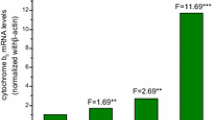Summary
Xenobiotic metabolic activation by intact hepatocytes was recently shown to be enhanced by the addition of nontoxic concentrations oft-butyl hydroperoxide and prevented by cytochrome P450 inhibitors (1). Furthermore, H2O2 (Km=103 μM) was found to be highly effective in supporting the human microsomal CYP1A2 catalyzed metabolic activation of the heterocyclic aromatic amine 2-amino-3-methylimidazo (4,5-f) quinoline (IQ) to mutagenic metabolites and the DNA adduct formed was the same as that formed by the mixed-function oxidase catalyzed activation system (2). In the following, it is shown that the cytotoxicity of other xenobiotics including carcinogenic arylamines and their N-hydroxyarylamine metabolites were markedly enhanced by hydroperoxide addition but not in the presence of cytochrome P450 inhibitors. The CYP1A2 dependent O-demethylation of methoxyresorufin in 3-methylcholanthrene induced hepatocytes was also markedly enhanced when intracellular H2O2 was generated by the mitochondrial monoamine oxidase (MAO) substrates tyramine or kynurenamine. Linoleic acid hydroperoxide also dramatically enhanced the cytotoxicity of phenelzine towards isolated hepatocytes and the microsomal metabolism of phenelzine to form ethylbenzene. The P450 inhibitors phenylimidazole, benzylimidazole prevented the metabolic activation of phenelzine but not lipid peroxidation. These results suggest that linoleic acid hydroperoxide can activate hydrazines via a cytochrome P450 peroxidase catalyzed one electron oxidation to form highly cytotoxic reactive intermediates. Furthermore, increased hydrogen peroxide formation, e.g. as a result of oxidative stress, would also be expected to enhance the metabolic activation of carcinogenic arylamines via the peroxygenase function of CYP1A2.
Similar content being viewed by others
References
Anari M.R., Khan S., Liu Z.C., O’Brien P.J. (1995): Cytochrome P450 peroxidase/peroxygenase mediated xenobiotic metabolic activation and cytotoxicity in isolated hepatocytes. Chem. Res. Toxicol., 8, 997–1004.
Anari M.R., Josephy P.D., Henrey T., O’Brien P.J. (1997): Hydrogen peroxide supports human and rat cytochrome P450 1A2-catalyzed 2-amino-3-methyl imidazo [4,5-f] quinoline bioactivation to mutagenic metabolites: significance of cytochrome P450 peroxygenase. Chem. Res. Toxicol., 10, 528–534.
O’Brien P.J. (1978): Hydroperoxides and superoxides in microsomal oxidations. Pharmacol. Ther., A2, 517–537.
Hycay E.G., O’Brien P.J. (1971): Cytochrome P450 as a microsomal peroxidase utilizing a lipid peroxide substrate. Arch. Biochem. Biophys., 147, 14–27.
Estabrook R.W., Martin-Wixtrom C., Saeki Y., Renneberg R., Hildebrandt A., Werringloer J. (1994): The peroxidatic function of liver microsomal cytochrome P450: comparison of hydrogen peroxide and NADPH catalysed N-demethylation reactions. Xenobiotica, 14, 87–104.
Penneberg R., Scheller F., Ruckpaul K., Pirritz J., Mohr P. (1978): NADPH and H2O2-dependent reactions of cytochrome P450LM compared with peroxidase catalysis. FEBS Lett., 96, 349–353.
Coon M.J., Vaz A.D.N., Bestervelt L.L. (1996): Peroxidative reactions of diversozymes. FASEB J., 10, 428–434.
Hecker M., Ullrich V. (1989): On the mechanism of prostacyclin and thromoboxane A2 biosynthesis. J. Biol. Chem., 264, 141–150.
Song W.C., Brash A.R. (1991): Purification of an allene oxide synthase and identification of the enzyme as a cytochrome P450. Science, 253, 731–734.
Matsui K., Shibutari M., Hase T., Kajurara T. (1996): Fatty acid hydroperoxide lyase is a cytochrome P450 (CYP74B). FEBS Lett., 394, 21–24.
Shimizu T., Murakami Y., Hatano T. (1994): Gln and Thr mutation of cytochrome P450 1A2 remarkably enhance homolytic O−O cleavage of alkyl hydroperoxides. J. Biol. Chem., 269, 13296–13304.
Reed C.J., DeMatteis F. (1989): Cumene hydroperoxide-dependent oxidation of tetramethyl phenylenediamine and 7-ethoxycoumarin by cytochrome P-450. Biochem. J., 261, 793–800.
Jatoe S.D., Khan S., O’Brien P.J. (1991): Molecular cytotoxic mechanisms of carcinogenic arylamines. Prog. Pharmacol. Clin. Pharmacol., 8, 245–253.
Moldeus P., Hogberg J., Orrenius S. (1978): Isolation and use of liver cells. Methods Enzymol., 52, 60–70.
Kreamer B.L., Staecker J.L., Saurada N., Sattler G.L., Hsia M.T.S., Pitot H.C. (1986): Use of speed, isodensity Percoll centrifugation method to increase the viability of isolated rat hepatocyte preparations. In vitro cell. Dev. Biol., 22, 201–211.
Reed D.J., Balson J.R., Beaty B.W., Brodie N., Potter D.W. (1980): High performance liquid chromatography analysis of nanomole levels of glutathione, glutathione disulfide, and related thiols and disulfides. Anal. Biochem., 106, 55–62.
Ortiz de Montellano P.R., Augusto O., Viola F., Kunze K.L. (1983): Carbon radicals in the metabolism of alkyl hydrazines. J. Biol. Chem., 258, 8623–8629.
Hanioka N., Jinno H., Takahashi A., Nakano K., Yoda R., Nishimura T.M. (1995): Interaction of tetrachloroethylene with rat hepatic microsomal P450-dependent monooxygenases. Xenobiotica, 25, 151–165.
Hammons G.J., Milton D., Stepps K. Guengerich F.P., Tukey R.H., Kadlubar F.F. (1997): Metabolism of carcinogenic heterocyclic and aromatic amines by recombinant human cytochrome P450 enzymes. Carcinogenesis, 18, 851–854.
Albano E., Comoglio A., Clot P., Iannone A., Ingelman Sundberg M. (1995): Activation of alkylhydrazines for free radical intermediates by ethanol-inducible cytochrome P-4502E1 (CYP2E1). Biochim. Biophys. Acta, 1243, 414–420.
Ortiz de Montellano P.R., Watanabe M.D. (1986): Free radical pathways in the in vitro hepatic metabolism of phenelzine. Mol. Pharmacol., 31, 213–219.
Wener P., Cohen G. (1991): Intramitochondrial formation of oxidised glutathione during the oxidation of benzylamine by monoamine oxidases. FEBS Lett., 280, 44–46.
Jones D.P., Eklow L., Thor H., Orrenius S. (1981): Metabolism of hydrogen peroxide in isolated hepatocytes: relative contributions of catalase and glutathione peroxidase in decomposition of endogenously generated H2O2. Arch. Biochem. Biophys., 210, 505–516.
Author information
Authors and Affiliations
Rights and permissions
About this article
Cite this article
Anari, M.R., Khan, S., Jatoe, S.D. et al. Cytochrome P450 dependent xenobiotic activation by physiological hydroperoxides in intact hepatocytes. Eur. J. Drug Metab. Pharmacokinet. 22, 305–310 (1997). https://doi.org/10.1007/BF03190961
Issue Date:
DOI: https://doi.org/10.1007/BF03190961




